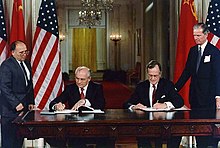Chemical weapons treaty

On June 1, 1990, the US President George Bush and the President of the Soviet Union , Mikhail Gorbachev , signed the bilateral chemical weapons agreement between the United States and the Soviet Union on the occasion of their second joint summit in Washington, DC . The treaty is officially as an agreement on the destruction and non-production of chemical weapons and on measures to facilitate the multilateral agreement on the prohibition of chemical weapons (English: Agreement on Destruction and Non-production of Chemical Weapons and on Measures to Facilitate the Multilateral Convention on Banning Chemical Weapons) became known. The bilateral agreement represented an important milestone in the disarmament of weapons of mass destruction.
Apron
The agreement is based on an initiative of President Bush in September 1989 that the United States and the Soviet Union should take the lead in destroying their chemical weapons stocks. This was an important step towards the conclusion of a comprehensive, verifiable global ban on chemical weapons .
Content of the contract
The bilateral agreement stipulated that the destruction of chemical weapons (CW) would begin before 1993 and that stocks would be reduced to no more than 5,000 tonnes (approx. 20 percent of the then stocks in the United States) by December 31, 2002. Before the destruction began, it had to be ensured that it could be carried out safely and in an environmentally friendly manner. The treaty also stipulated that both sides would cease CW production after the agreement came into force and encourage all states capable of chemical weapons to follow suit. On-site inspections should monitor whether the destruction actually took place.
The arsenals of the states that joined in 2007 were supposed to have been destroyed by 2012. However, Russia and the US have long lagged behind schedule. The US wants to have its stocks destroyed by 2023. Russia announced the execution in September 2017.
vision
The bilateral agreement should give new impetus to the conclusion of a comprehensive and verifiable global chemical weapons ban. This project also succeeded with the adoption of the Chemical Weapons Convention on September 3, 1992 by the member states of the Geneva Disarmament Conference . The convention came into force on April 29, 1997.
Web links
- ARD Tagesschau from June 1, 1990 (from 05:30)
- Chemical Weapons WMD Around the World On: Federation of American Scientists
- United States of America: Chemical Weapons Profile Auf: Institute for Defense Studies and Analyzes (IDSA)
Individual evidence
- ^ The Washington / Camp David Summit 1990: From the Secret Soviet, American and German Files Auf: National Security Archive
- ^ Chemical and Biological Weapons Chronology Auf: Federation of American Scientists
- ^ Goldblat: ARMS CONTROL - The New Guide to Negotiations and Agreements. Trowbridge 2002, p. 147
- ^ Summit in Washington Summary of the US-Soviet Agreement on Chemical Arms In: The New York Times, June 2, 1990
- ↑ Chemical Weapons Control, What is the OPCW? In: Spiegel from April 4, 2018
- ↑ Sharp criticism of the USA; Russia destroys the last chemical weapons In: n-tv from September 27, 2017
